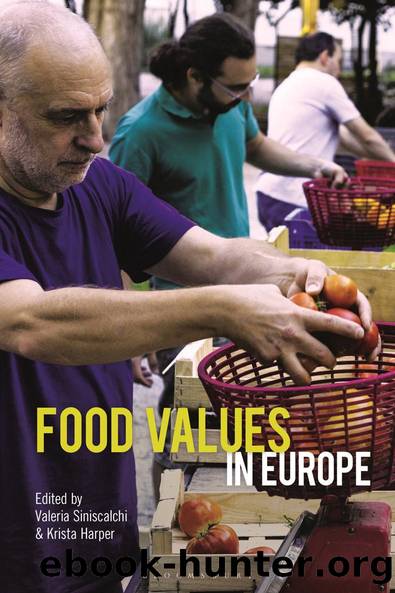Food Values in Europe by Valeria Siniscalchi Krista Harper

Author:Valeria Siniscalchi, Krista Harper [Valeria Siniscalchi, Krista Harper]
Language: eng
Format: epub
ISBN: 9781350249158
Barnesnoble:
Publisher: Bloomsbury Academic
Published: 2021-03-25T00:00:00+00:00
Figure 8.2 Members of a basket visiting the producerâs farm (©Franco Zecchin).
In this protected space, economic proximity means the possibility to discuss economic questions inside (increases in basket prices) and outside (increased labor costs for the farmers, taxes, etc.) the system. They discuss problems, possible forms of assistance, and costs that the producer must absorb. These include not only what is happening in the fields but also how these issues affect the âbot tom lineâ of the producer. âOnce all the expenses are deducted, we are left with a profit margin of 10%. If the number of baskets drops 10%, we lose our incomeâ (M. C. farmer PAMA, 2016). The producerâs income seems to be calculated on the basis of a certain number of baskets that his farm can provide. If the number of members decreases (i.e., the number of baskets âsoldâ), incomes also fall. The system also offers protection against fluctuations in the market, and associated speculation.
In the classical market, when you sell to large-scale retailers, every day the strawberries are worth a certain price, the next day it goes down or it goes up, because it is the supply and the demand, the more strawberries, the less expensive they are. We are not in that system, we have a linear price during the year. . . . Even if the selling price is not very high and we are not going to become rich selling the baskets, we ensure regular sales. Our only issue is being able to grow the maximum of vegetables to fill the baskets, but [the basket] is already sold and that is really good point. (L. P., farmer with PAMA, 2013)
The price helps secure the loyalty of the members while providing small producers with a guarantee of the sale of their produce and protection from the vagaries of the market. At the beginning of the contract prices, varieties of vegetable, and other elements concerning the production or the distribution are expected to be decided by the producer âandâ (or in agreement with) the consumers. As previously noted, the basket price is not directly related to the variety, quantity, or a per unit price, and one of the primary objectives of the system is to remove the transaction from the market, including this aspect of pricing. However, most producers actually calculate the quantity of weekly vegetables based, to some extent, on market prices.
[The price] itâs global, itâs true that there isnât a relationship between the weight and the price. We establish [the price] by comparing, not by calculating our basket . . . instead, we get to have a sense of the value of a basket. . . . You make a comparison with, if our members had bought the same basket at the supermarket. Sometimes I [also] check the prices in the stores. (T. G., farmer with PAMA)
Regardless of the way the comparison or calculation is made, the prices for these exchanges, seen as âoutside of the market,â tend to be slightly lower but close to the market prices for comparable products.
Download
This site does not store any files on its server. We only index and link to content provided by other sites. Please contact the content providers to delete copyright contents if any and email us, we'll remove relevant links or contents immediately.
Cecilia; Or, Memoirs of an Heiress — Volume 1 by Fanny Burney(31320)
Cecilia; Or, Memoirs of an Heiress — Volume 3 by Fanny Burney(30927)
Cecilia; Or, Memoirs of an Heiress — Volume 2 by Fanny Burney(30883)
The Great Music City by Andrea Baker(21136)
We're Going to Need More Wine by Gabrielle Union(18062)
Bombshells: Glamour Girls of a Lifetime by Sullivan Steve(13098)
Pimp by Iceberg Slim(12920)
All the Missing Girls by Megan Miranda(12736)
Fifty Shades Freed by E L James(12442)
Norse Mythology by Gaiman Neil(11867)
Talking to Strangers by Malcolm Gladwell(11852)
Crazy Rich Asians by Kevin Kwan(8340)
Mindhunter: Inside the FBI's Elite Serial Crime Unit by John E. Douglas & Mark Olshaker(7823)
The Lost Art of Listening by Michael P. Nichols(6457)
Enlightenment Now: The Case for Reason, Science, Humanism, and Progress by Steven Pinker(6400)
Bad Blood by John Carreyrou(5759)
The Four Agreements by Don Miguel Ruiz(5500)
Weapons of Math Destruction by Cathy O'Neil(5026)
We Need to Talk by Celeste Headlee(4857)
